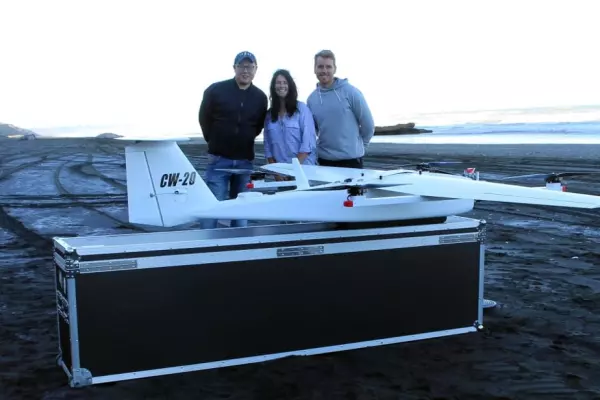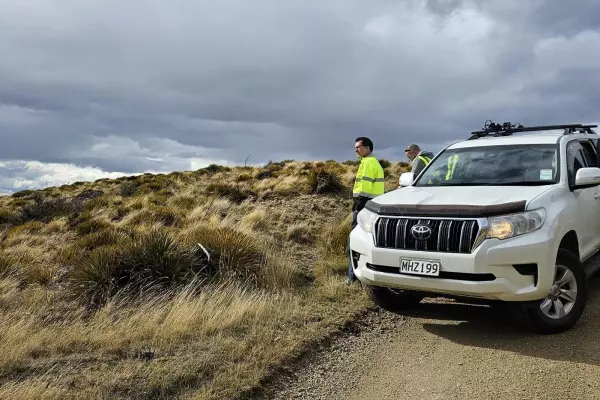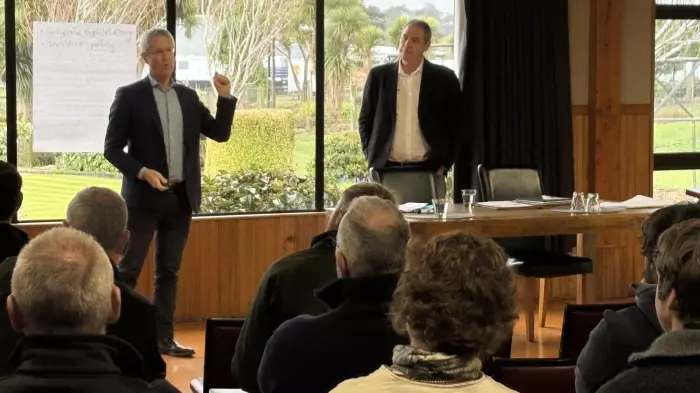This article was prepared by Spark and is being published by BusinessDesk as part of the Productivity Unleashed partnership.
Satellite broadband is an excellent solution for businesses in areas prone to landslides or frequent excavation, which can lead to cut fibre cables and interrupted connectivity.
However, many businesses suffer from satellite hesitancy. Will it keep working in bad weather conditions, under thick cloud cover? What about speeds? Can it cope with video?
For Discover Waitomo, home to New Zealand's world-famous tourist attractions: the Waitomo Glowworm Caves, the Legendary Blackwater Rafting Co, and the Waitomo Homestead, Spark’s Starlink satellite offering has been rock solid.
- Challenge: Replace damage-prone VDSL copper connection with performant internet connectivity serving high-volume customer sites in remote pockets of the northern King Country.
- Solution: Starlink internet from authorised reseller Spark: high-speed, low latency satellite internet – including site surveys and design, and installation support – bringing connectivity to remote sites.
- Result: Discover Waitomo’s internet stays reliable in all conditions. With landslides and excavation mishaps no longer a threat to cables, the tourism operator confidently goes cashless and harnesses seamless connectivity to amplify shared experiences on social media.
Connectivity is confidence
Tourism is New Zealand’s second-largest export earner. The many natural wonders attracting visitors to our shores are often found in rugged wilderness. Businesses that protect and showcase these taonga (treasures) rely on high-performance connectivity to keep operations running and visitors coming.
Nestled in the scenic valleys of the northern King Country, Discover Waitomo welcomes around 450,000 international visitors each year. Switching to Starlink’s high-speed internet has been a game-changer, providing the speed and reliability to go cashless and make Waitomo’s star attractions more shareable in a digital world.
Three big benefits for Discover Waitomo
- High performing internet connectivity – in all conditions: Lightning, fog, landslides, or wayward excavators – no problem. The connectivity issues that once plagued Discover Waitomo’s cable-based internet are a thing of the past.
- Going cashless: Customers expect cashless transactions. With Starlink, Discover Waitomo confidently accepts payments via cards and mobile devices.
- More shareable: Reliable Wi-Fi lets thousands of visitors share their adventures the moment they resurface – turning every post into powerful marketing.
Curse of the roadside excavator
David Goldman, Discover Waitomo’s IT operations manager, estimates that in his 12 years with the tourism operator, the fibre link running alongside State Highway 3 – Waitomo’s main visitor access route – has been severed 30 times.
Roadside excavators are partly to blame, but the region’s wet climate (1537mm annual rainfall) and unstable geology – clay and silt loam over Oligocene limestone – create ideal conditions for slips and washouts that wreak havoc on underground cables.
With VDSL (Very high-speed Digital Subscriber Line) being phased out, Discover Waitomo saw a growing vulnerability it needed to address. Like most tourism operators, it can’t function without reliable connectivity. Outages force frantic workarounds for ticketing, system access, emergency response, and cave ecosystem monitoring.
Mobile networks provide secondary options for data connections, but in the deep bush-clad expanse of the Waitomo district, coverage isn’t ever a sure thing. In any case, Goldman had experienced several instances when both internet and mobile networks failed simultaneously. The absence of a dependable fallback position made him nervous.
“We’re constantly reminded of how delicate the infrastructure of regional New Zealand really is and how at risk we are,” Daniel Thorne, Discover Waitomo’s general manager, said.
“We're open 365 days a year and we need connectivity for both the business side of things as well as making sure people have a smooth visit once they get here. And then there’s health and safety, our commitment to Kaitiakitanga (guardianship), and protecting our natural taonga (treasure) for generations to come. Everything we do relies on connectivity.”
Satellite hesitancy
Seeing the steep cost of running fibre to Discover Waitomo’s caving operations, David Goldman decided to put Starlink to the test. With its growing popularity – New Zealand’s Starlink user base more than tripled in a year to 37,000, the highest per capita in the OECD, according to the 2023 Commerce Commission Telecommunications Monitoring Report – it seemed like a promising solution.
Still, Goldman had doubts. Would satellite internet hold up against Waitomo’s rugged terrain and harsh weather? “At first, I was hesitant because of the weather – it gets extremely cloudy and windy out here, and some areas are very exposed,” he said. “My biggest worry was what if it went down? The business would stop working.”
Starting small
Undeterred, Discover Waitomo installed a residential-grade Starlink connection at its Ruakuri Caves site, 5km southwest of the main glowworm caves. With limited 4G coverage in the area, Goldman saw it as a true test for satellite internet – and he was quickly impressed.
“You can barely make phone calls out there,” he said. “We installed a residential Starlink connection link and ran it for a few months. It never went down – it just kept running, and as soon as Fibre went down a few more times, I was like, OK, let's give this a go.”
Going large
The success at Ruakuri encouraged Goldman to run a proof-of-concept for a business-grade version of Starlink, which features a larger, higher-gain dish, at the Waitomo Homestead, a café, restaurant, and gardens, with accommodation options.
“Again, Starlink was rock solid through a few storms,” he said. “I'll be honest, I was a little surprised with how well it performed. And that's when we decided Starlink was the best bet for remote areas.”
A Starlink installation at the firm’s The Legendary Blackwater Rafting Co base came next.
Goldman is now a big fan and particularly impressed with Starlink’s speed. “It's just stunning – and there's no latency. There’s nothing to worry about. We’re used to 100-plus megabit connection speeds – and that’s enough.”
Starlink users typically experience download speeds between 25 and 220 Mbps, which at the top-end is 20x faster than VDSL broadband, according to figures from the Measuring Broadband New Zealand report, June 2024. Indicative business-grade plans list speeds including 40-220 Mbps-plus download, 8-25 Mbps-plus upload, and 25-60 ms latency on land.
Homestead guests streaming video and sharing photos via onsite Wi-Fi are a good strain gauge for the satellite internet service. “Video streaming is definitely the biggest consumer of bandwidth, but it seems to handle it,” Goldman said.
Bandwidth a big deal for shareability
Social media is perhaps the most powerful promotional lever for tourism operators. “From a marketing perspective, if we can make visitor experiences more shareable that's a huge commercial benefit,” Thorne said.
On this front, Starlink might be the company’s greatest marketing accessory, most evident at Discover Waitomo’s blackwater rafting base and launch site, where excited tourists eagerly upload clips of their underground experience.
The frequent faults and slower speeds of onsite VDSL made the process of supplying photos of the rafting experience to customers painfully slow. “Starlink has been a massive help,” Thorne said. It also encouraged the firm to go ‘cashless’ at its blackwater rafting base – something they wouldn’t have considered without reliably fast connectivity.
Looking ahead
Plans are afoot to install a Starlink connection at Discover Waitomo’s most touristed site, the Waitomo Glowworm Caves, once a site for the satellite dish has been confirmed. The caves entry point is in a steep valley and has a large permanent outdoor shelter, which means the dish must be located distal to the caves site itself. Placement also needs to be sensitive to the natural environment and mana whenua.
Thinking about Discover Waitomo’s enhanced powers of internet connectivity, Thorne said the door is now open to additional monitoring of the cave network. While its VDSL connection, for the most part, relays measures of CO2, temperature, and alarms, a more performant connection could support consistent real-time monitoring, such as stream levels, in more places.
“We’re really proud of our ability to keep people safe,” Thorne said. “But a more reliable connection will allow us to think about expanding monitoring and to do it more frequently.”
Working with Spark
Starlink offers a simple solution, but small missteps can have big consequences.
Spark technicians visited Discover Waitomo sites to test and validate satellite signals, situate the satellite dish in the optimal position, gauge power and cabling requirements, and identify any accessories or aftermarket components that might be required.
“Technology is such a broad field,” Goldman said. “I don’t know much about satellite positioning or that sort of thing. So, it's definitely useful having an expert who knows the hardware and how it should be set up to get the full potential from the product. There are a lot of nuances you’ve got to get right.”
In the end
New technology makes big promises, but big promises often lead to new disappointments. Starlink is the exception. Discover Waitomo was aware of the hype surrounding Starlink, but didn’t expect the consistent level of speed and performance it has delivered.
“Spark’s help made us comfortable with satellite possibly years earlier than we would have on our own,” Thorne said. “It’s been huge and it’s given us the confidence to know that it will perform for the business and our shareholders.”
“When you don't have ultra-fast cable connectivity, satellite works,” Goldman said. “To my surprise, it just works.”













